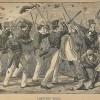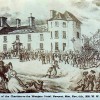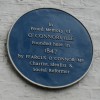Kersal Moor
Kersal Moor is an area of moorland located in the Kersal district of Greater Manchester in northern England. It was an important recreational area as Manchester industrialized, and was used for pursuits including horse racing from the seventeenth century. It was used for Chartist meetings in the nineteenth century, including the Great Chartist Meeting of 24 September 1838. Related BRANCH article: Chris R. Vanden Bossche, "On Chartism."
Coordinates
Latitude: 53.515278000000
Longitude: -2.276389000000
Longitude: -2.276389000000





